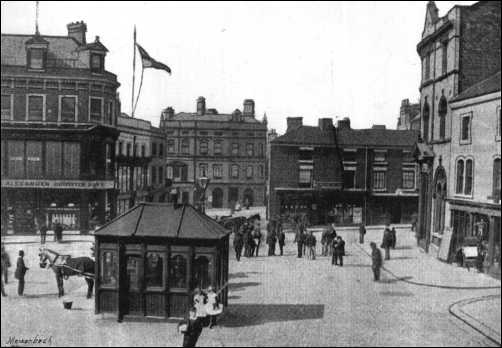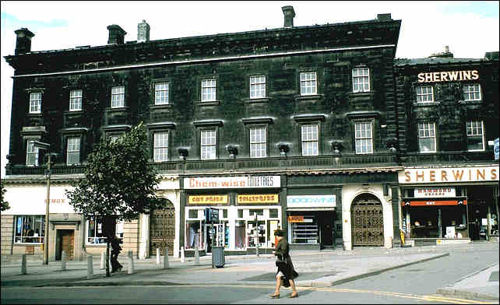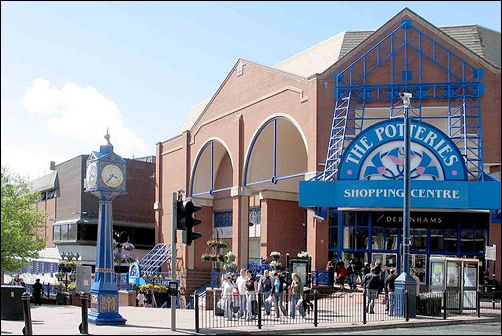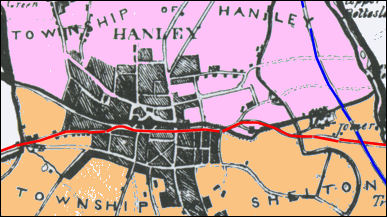|
Hanley
- 'Hanley Lower Green - a collision of roads'
  
click the
"contents" button to get back to the main index & map
next:
Etruria 'a factory in
a garden'
previous:
Stoke Road, Howard
Place & Snow Hill
|
Historian Fred Hughes
writes....
The gateway to Hanley
from the Cultural Quarter is noted by a collision of roads lined with
clusters of business and retail garrisons converging upon a single hub.
And right in the middle of it all pride of place is given, not as you
would think to a Potteries’ iconic monument, but to a more ironic edifice
– a public lavatory. Reg Booth is a councillor for Hanley. What does he
think of a bog-standard toilet occupying such an eye-catching spot?

Crown Bank,
Hanley - 1893
This area was the centre for the horse drawn cabs.
In the middle of Crown Bank was a small green roofed building - this was
the cab drivers shelter (demolished in 1907)
occupying this location today are public toilets
“There are many things
wrong with Hanley,” he responds, “A lavatory in this location is a strange
choice. But we inherited a town layout which we are trying to make into a
city centre. Sometimes these things transform easily but more often they
take time. The plans for a future Hanley are spectacular but they are
miles away from achievement. Only time will tell.”
Reg thinks there’s still
a problem of identity......
He
says, “It’s been said before but nevertheless it remains a fact that
people in other towns have no reason to shop in Hanley. Yes, the big
stores are here. But big stores also trade on peripheral retail sites
where it’s easier to park. People tell me Hanley is shabby in the day
and risky at night; too many hideaways. Hanley hasn’t got a central
square. It was Fountain Square but I think it’s been spoiled by moving
the fountain and statue.”
|
These days Fountain
Square is hemmed in by, depending on your taste, some really
monotonous architecture. On the other hand you might think the façade of
TX Maxx and Goldsmith Jewellers on Moxon’s Island, are better than the
former Victorian frontage of Pidducks Jewellers. But jeweller and
clockmaker Christopher Skelhorne thinks like me.
“I worked at Pidduck’s
when I left high school until it closed in 1982,” says Christopher.
“Robert Featherstone Goodall was manager – they don’t construct strong
names like that anymore – and joint director was Neil Harrison. If those
two and others like Len and Roy Evans from Goodson’s, perhaps the
Derricott brothers, or even the well-known drunk Vincent Riley could see
Fountain Square as it is now they wouldn’t recognise it.”
Age 69 Christopher
maintains a successful business in Piccadilly Arcade with his wife Sylvia
and long-serving staff Jane Mellor and Elaine Underwood, all former
employees of Pidduck’s Jewellers.
“I loved Hanley then,”
reminisces Jane. “Hanley was just lovely to roam around in with so many
interesting places to see. Simple things like the spiral staircase in
Sherwin’s music shop were a delight.”
|
Have we come so far that
we don’t recognise Hanley as an individual town anymore? Does it have to
be the city centre?
“Geographically it
hasn’t changed at all,” says historian Steve Birks. “What has changed is
the way we use it. Until the end of the 1960’s Hanley was still a
Victorian town. First to change was traffic and how we manage it. Not long
ago you could drive through Miles Bank and into Market Square, in fact
along all the town centre streets. The residential population then was
higher, now very few live here. Next we changed our leisure habits; we
stay at home rather than coming to town at night. And importantly our
shopping habits changed. As family-owned shops gave way to chain stores
Victorian buildings conceded ground to the modern flash that new shopping
malls demand.”

Hanley Indoor Market
The whole of the market area was demolished
to
make way for the Potteries Shopping Centre

Potteries Shopping Centre
photo: 2006 - fotodiscs
|
I wonder how all this
began. Helpfully Steve provides some background.
“Shelton and Hanley
share a boundary at Stafford Street. If you stand at the top of Piccadilly
and look through Crown Bank you’ll see the unbalanced layout that was
formulated by the extension of its market over generations. Hanley is on
the side of a hill and if you look from the air it fits exactly the
description given to it by a chap named J W Plant, a city planning officer
who, in 1960, described Hanley as ‘an archipelago of island sites’.”
And that rather dreamy
description is exactly what Hanley is. It’s what fortifies it with a
pleasing Je ne sais quois.
“The buildings
occupying Plant’s variously shaped islands have been replaced piecemeal as
far back as the early 19th century,” continues Steve. “From the start the
central architecture was structured in widely differing heights, styles,
and materials. And because of Hanley's emergence as Stoke on Trent’s
commercial and retail centre, this lack of uniformity is even more
pronounced than in the other Pottery towns.”

Townships
of Hanley & Shelton in 1842
The dividing line was present day Stafford
Street
(the red line as it passes through the built up area)
But
where is Hanley and why should it be the city centre?
“In the 17th
century, Hanley consisted of two small hamlets, Upper Green and Lower
Green,” explains Steve. “Lower Green is where Market Square is today. Then
they were little more than two small villages half a mile apart. They came
together as a result of a buoyant market and through the centralisation of
specialist trading. By 1775 Hanley, or Hanley Green as it was sometimes
known, had spread westwards into Shelton – remember the boundary is
Stafford Street. Even by 1790 Hanley was still smaller than Burslem. But,
as the Victoria County History describes it, Hanley then was ‘an improving
and spirited place built so irregularly that, to a person in the midst of
it, it has scarcely the appearance of anything beyond a moderate village;
yet if the houses had been properly joined together, it would not only
make a capital town but a well-built one’.” |
I reckon that sums
Hanley up. Although its architecture and use continues to transform,
Hanley is still the archipelago of retail islands designated by the
prosaic 1960’s council official. Meanwhile Christopher Skelhorne continues
to treasure fond memories of old Hanley.
“Hanley will always be
the best place to establish a business,” he says. “I am a specialist in
a specialist trade with a dedicated clientele. Yes Hanley has changed
and it will continue to.”
But
will Hanley become a different, a better city centre? “I’m sure it will,”
says Reg Booth. “But only time will tell.”
 Hanley and
its development
Hanley and
its development
 Hanley, one of the
six towns
Hanley, one of the
six towns
next week: Etruria
  
click the
"contents" button to get back to the main index & map
next:
Etruria 'a factory in
a garden'
previous:
Stoke Road, Howard
Place & Snow Hill
|